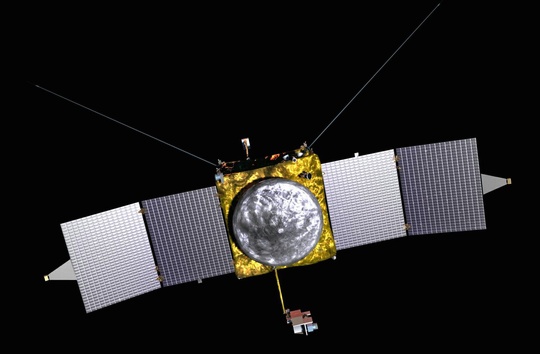A new proposed spacecraft named MAVEN (Mars Atmosphere and Volatile EvolutioN) is expected to be launched in 2013, a $485 million mission to collect atmospheric data on Mars. The purpose of the NASA’s Mars Exploration Program is to gain further knowledge on the history of the planet’s climate and atmosphere, as well as the planet’s availability of water and its future habitability.
“Today, the martian atmosphere is about half a percent as dense as the Earth’s and it’s about 95 percent carbon dioxide, which makes it very thin and very dry,” states John T. Clarke, an Astronomy Professor at Boston University, who predicts two possible happenings for Mars’ missing atmosphere: Either it had been pulled from the planet’s weak gravitational hold and escaped into the vastness of space, or it became a frozen layer within the planet’s current crust such as the permafrost layer on Earth.
Boston University’s center for Space Physics was initially recruited, along with University of Colorado at Boulder, to develop an instrument that will be able to determine the presence of a heavier atom of Hydrogen, named deuterium. Deuterium is an isotope of hydrogen having most of the same chemical properties, except for the atomic mass. Unlike its parent atom, deuterium contains not one, but two neutrons, resulting in a heavier particle.


Hydrogen Atom Deuterium Atom
Clarke is an expert in detecting the unique characteristics of different types of water molecules, and will prove to be a sufficient addition to the Mars’ team. In 2009 he is expected to lead an engineering and astronomy team toward developing instruments for NASA’s spacecraft to test for these isotopes. The findings will be important in determining water percentages that have escaped off Mars and into the atmosphere.
“Mars once had a denser atmosphere that supported the presence of liquid water on the surface,” Said Douglas McCuistion, Director of the Mars Exploration Program with NASA. “The loss …has been an ongoing mystery, and MAVEN will help us solve it,”
MAVEN is expected to launch as scheduled and will arrive near Mars late 2014 where it will elliptically orbit the planet between 90 and 3,870 miles above the surface. The spacecraft will be equipped with eight instruments which are planned to take recording of the atmosphere for a full year. It will then drop to a measure of 80 miles from the surface to gather data samples of Mars’ entire upper atmosphere.
“MAVEN will obtain critical measurements,” says Michael Meyer, the Chief Scientist on Mars at NASA headquarters.
NASA's Mars Exploration Program seeks to understand Mars as a dynamic planet, including its present and past environment, climate cycles, geology and biological potential, and the possibilities of future habitability.


References:
Harold C. Urey and Gordon K. Teal, Hydrogen Isotope of Atomic Weight Two. Reviews of Modern Physics Vol. VII, No. 1. (1935); NASA Selects 'MAVEN' Mission to Study Mars Atmosphere. 15 September 2008. NASA.; Boston University astronomers en route to Mars. 17, September 2008. Eurekalert.






Comments